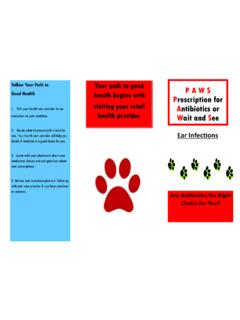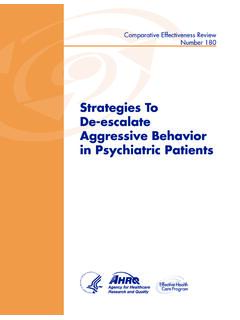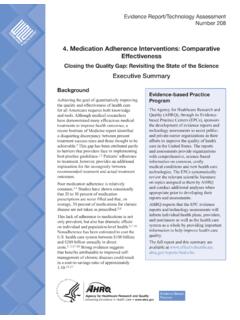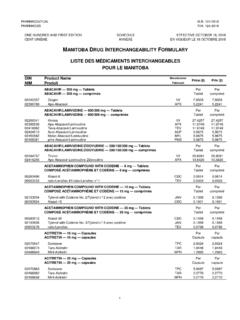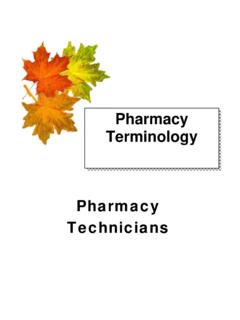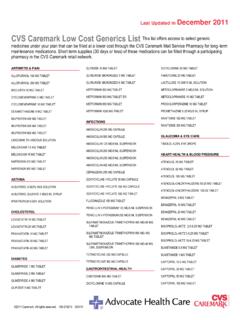Transcription of Diagnosis and Management of Gout: Current State of the ...
1 Diagnosis and Management of gout : Current State of the EvidenceFocus of This Summary This is a summary of two systematic reviews. One review evaluated the evidence regarding the accuracy and safety of tests used to initially diagnose gout in the primary care, urgent care, or emergency care setting. The other review examined the evidence base for treating patients with acute gout attacks in the primary care setting. The former systematic review included 27 articles published through February 29, 2016, and is available at The latter systematic review included 154 articles published through March 1, 2016, and is available at This summary is provided to assist in informed clinical decisionmaking. However, reviews of evidence should not be construed to represent clinical recommendations or guidelines.
2 Muscle, Bone, and Joint ConditionsGoutBackground gout is a form of inflammatory arthritis that presents as joint swelling and pain, referred to as a gout flare or a gout attack. Upon resolution of a gout attack, patients enter a symptom-free period. However, gout attacks recur in many patients. Patients with gout may develop gouty arthritis or tophaceous gout (solid deposits of monosodium urate [MSU] crystals in skin, soft tissue, and joints) in the long patients with gout are diagnosed and managed in the primary care, urgent care, or emergency care setting. It is critical to exclude septic arthritis and other causes of inflammatory arthritis in the acute care setting. Recent guidelines use assessment of MSU crystals in joints and synovial fluid as the gold standard for gout Diagnosis along with history and a physical exam.
3 However, joint aspiration for synovial fluid can be challenging to perform in small joints (such as in toes) and to interpret. The role of clinical algorithms (which often draw upon clinical signs, symptoms, and laboratory tests) in the Diagnosis of gout is being investigated in clinical studies. Imaging methods (such as dual-energy computed tomography [DECT] and ultrasound) are mainly used in the Diagnosis of complex cases of for gout attacks include nonsteroidal anti- inflammatory drugs (NSAIDs), colchicine, and corticosteroids to control pain and inflammation. Nonpharmacological methods advocated for managing hyperuricemia in patients with gout include weight loss, exercise, alcohol restriction, sufficient hydration, and dietary changes. Urate-lowering medications are the primary pharmacological intervention for managing hyperuricemia.
4 The two systematic reviews summarized here assessed the accuracy of tests to diagnose gout and also examined the evidence regarding the treatment of gout in the primary care Diagnosis of gout : Two recently developed clinical algorithms to diagnose gout the Diagnostic Rule and the Clinical gout Diagnosis demonstrated sensitivities of 88 percent and 97 percent, respectively, and specificities of 75 percent and 96 percent, respectively, when compared with MSU crystal analysis (see Table 1). The strength of evidence (SOE) supporting the use of these clinical algorithms was moderate; these algorithms have not yet been validated in primary care, emergency care, and urgent care settings. The strength of evidence regarding the use of DECT (sensitivity: 85 100%; specificity: 83 92%) or of ultrasound (sensitivity: 74%; specificity: 88%) to diagnose gout was of gout : Effective treatments for gout attacks include NSAIDs, colchicine, and corticosteroids (high SOE; see Table 2).
5 Urate-lowering therapy (ULT), including allopurinol and febuxostat, reduced serum urate levels (high SOE; see Table 3). ULT did not reduce the frequency of gout attacks during the initial 6 months of therapy (high SOE), likely because of increased risk of gout attacks with initiation of ULT. The increased risk of gout attacks with initiation of ULT was ameliorated with the concomitant use of prophylactic agents (such as colchicine or NSAIDs) against gout attack (high SOE). After 12 months of ULT, the frequency of gout attacks was reduced (moderate SOE). The evidence was too limited to determine if dietary and lifestyle changes are effective in managing gout . This does not mean that dietary and lifestyle changes do not work. Clinicians may wish to consult clinical guidelines ( ) regarding the role of diet and lifestyle changes in the Management of SummaryeStrength of Evidence Scale High: High confidence that the evidence reflects the true effect.
6 Further research is very unlikely to change our confidence in the estimate of effect. Moderate: Moderate confidence that the evidence reflects the true effect. Further research may change our confidence in the estimate of effect and may change the estimate. Low: Low confidence that the evidence reflects the true effect. Further research is likely to change our confidence in the estimate of effect and is likely to change the estimate. Insufficient: Evidence either is unavailable or does not permit a of Clinical Research Evidence Two clinical algorithms, the Diagnostic Rule and Clinical gout Diagnosis , were evaluated as tools for diagnosing gout . Both of these algorithms were developed and validated with patients first identified in primary care and whose Diagnosis did not include an MSU assessment.
7 The Diagnostic Rule: The diagnostic components of this algorithm include clinical characteristics (>1 attack of acute arthritis, maximum inflammation developed within 1 day, redness observed over joints, painful or swollen first metatarsophalangeal joint) and risk factors (hyperuricemia, male sex, hypertension, or >1 cardiovascular disease event). Additional information is available in the article by Janssens and colleagues (Arch Intern Med. 2010 Jul;170[13]:1120-6. PMID: 20625017). Clinical gout Diagnosis : The diagnostic components of this algorithm include clinical characteristics (>1 attack of acute arthritis, maximum inflammation developed within 1 day, monoarthritis/oligoarthritis attack, redness observed over joints, painful or swollen first metatarsophalangeal joint, unilateral tarsal joint attack, tophi) and risk factors (hyperuricemia).
8 Additional information is available in the article by Vazquez-Mellado and colleagues (Clin Rheumatol. 2012 Mar;31[3]:429-34. PMID: 21979446). Diagnostic imaging studies that were evaluated in this review included DECT and ultrasound. The overall evidence grade was assessed based on the ratings for the following domains: study limitations, directness, consistency, precision, and reporting bias. Other domains that were considered, as appropriate, included dose-response association, plausible confounding, and strength of association ( , magnitude of effect). For additional details on the methodology used to assess strength of evidence, please refer to: Owens DK, Lohr KN, Atkins D, et al. AHRQ series paper 5: grading the strength of a body of evidence when comparing medical interventions Agency for Healthcare Research and Quality and the Effective Health-Care Program.
9 J Clin Epidemiol. 2010 May;63(5):513-23. PMID: 2: Effectiveness of Treatments for Acute gout Attack: Key FindingsStrategyN Studies N SubjectsFindingSOEC olchicine2 RCTs229 Reduces pain when compared with placebo 1 RCT184A lower dose of colchicine is as effective as a higher dose but with fewer side effects NSAIDs 1 RCT and observational data30 (in RCT)Reduce pain 16 RCTs1280No differences among NSAIDs in effectiveness Corticosteroids4 RCTs297 Reduce pain as much as NSAIDs Animal-derived ACTH (not commonly used in clinical practice)2 RCTs107 Reduces pain as much as NSAIDs ACTH = adrenocorticotropic hormone; N = number; NSAIDs = nonsteroidal anti-inflammatory drugs; RCT = randomized controlled trial; SOE = strength of evidence The known anti-inflammatory action of these agents was considered when assessing SOE.
10 Table 1: Accuracy of Diagnostic Methods for gout With MSU Analysis as the Reference Standard: Key FindingsDiagnostic MethodN Studies N SubjectsFindingSOEC linical algorithm: The Diagnostic Rule31383 Sensitivity: 88%Specificity: 75% Clinical algorithm: Clinical gout Diagnosis31383 Sensitivity: 97%Specificity: 96% Dual-energy computed tomography4235 Sensitivity: 85% to 100%Specificity: 83% to 92% Ultrasound8633 Sensitivity: 74%Specificity: 88% MSU = monosodium urate; N = number; SOE = strength of evidenceTable 3: Effectiveness of Strategies for Managing Hyperuricemia in Patients With gout : Key FindingsStrategyN Studies N SubjectsFindingSOEM anagement of hyperuricemiaULT vs. placebo4 RCTs1378 Reduces serum urate 2 RCTs1129 Does not decrease the risk of acute gout attacks within the first 6 months 1 open-label extension studyNRReduces the risk of acute gout attacks after 1 year Febuxostat vs.


